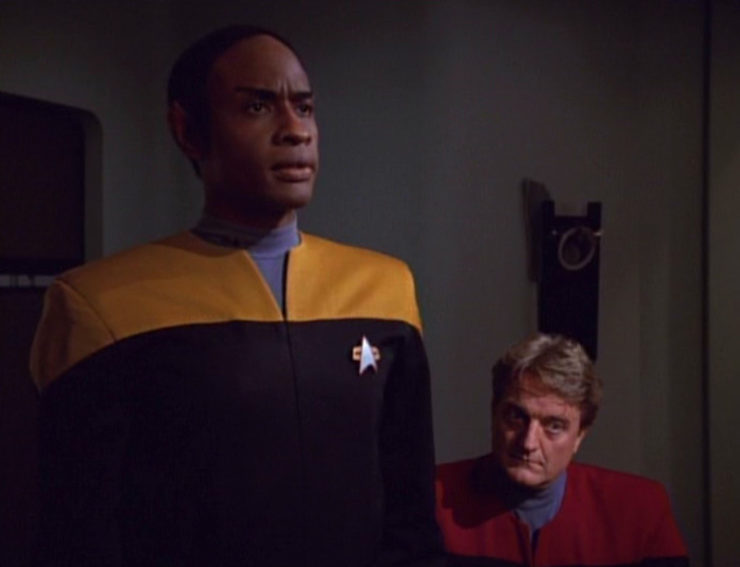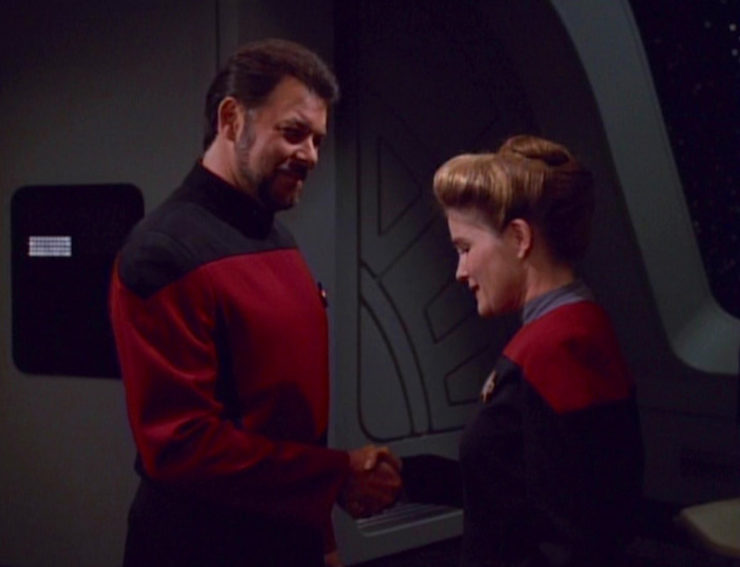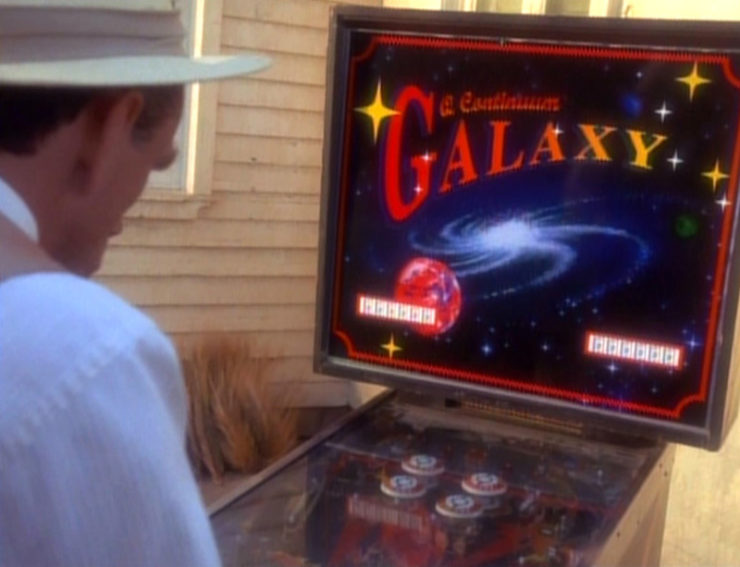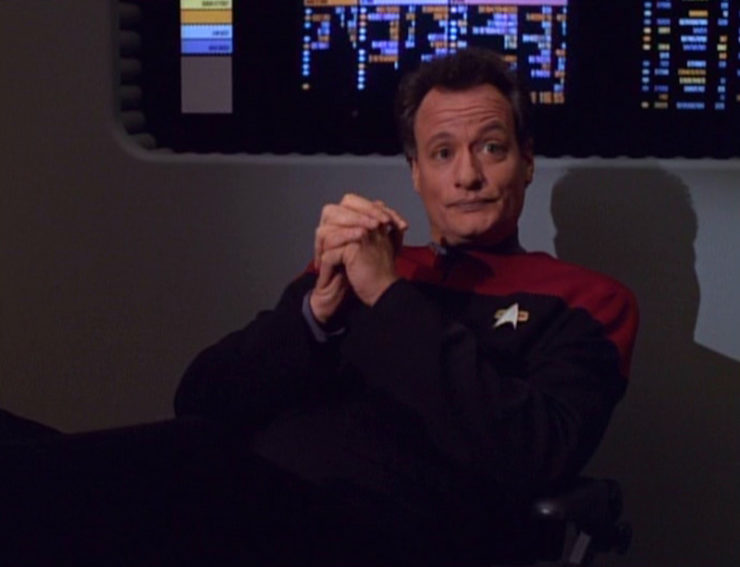“Death Wish”
Written by Shawn Piller and Michael Piller
Directed by James L. Conway
Season 2, Episode 18
Production episode 130
Original air date: February 19, 1996
Stardate: 49301.2
Captain’s log. Voyager encounters a comet that does not seem to be following a natural path—it’s unaffected by gravity or anything else, just kind of going its own way. Janeway is curious, and so has Torres beam a fragment of the comet on board for analysis.
To Torres’s surprise, what materializes is a humanoid form in a Starfleet uniform who walks through the force field and who identifies himself as Q. Upon hearing that, Janeway calls for red alert and goes to the transporter room.
This is not the same Q that tormented the Enterprise, as he’s a bit more scattered. (At the episode’s end, he takes on the name “Quinn,” and for ease of reference and to distinguish him from the other Q, he will be referred to as Quinn throughout this rewatch entry.) He brings himself and Janeway and Torres to the mess hall, and creates a sumptuous repast for them. He is fascinated by the mortals on board, particularly Kes with her short lifespan, but he also needs to act quickly before the rest of the Q-Continuum knows he’s out of the comet.
He gives a speech that he’s been practicing for three hundred years as his last words (“I die not for myself, but for you”), and then gestures. But instead of him dying, he instead makes all the male crew disappear. Janeway angrily demands he restore them, but Quinn says he doesn’t know how.
Buy the Book


To Sleep in a Sea of Stars
Then Q shows up, wondering what Quinn did this time. He thinks Quinn brought Voyager to the Delta Quadrant—a good hundred years ahead of schedule for the Federation to be there—but Quinn protests his innocence and says they freed him from the comet. Q realizes that Quinn tried to commit suicide and instead got rid of all the men. Q restores the male crew and then is about to take Quinn away when Quinn asks Janeway for asylum.
Quinn then takes Voyager away from Q, bringing the ship to the Big Bang. However, Q himself has hidden there from the Continuum and finds them, and he also finds them when Quinn makes them subatomic particles and into a Christmas tree ornament. (Ooooh, meta.)
Finally, Janeway asks them to please stop playing cat-and-mouse with her ship. Quinn has requested asylum, and standard procedure is to hold a hearing. All parties agree, with Quinn agreeing to return to the comet where he was imprisoned if he loses, and Q agreeing to make Quinn mortal so he can commit suicide if Q loses. Quinn also asks Tuvok to represent him at the hearing, as Quinn believes that Tuvok will be a strong advocate for him.
Quinn was imprisoned in the comet for wishing to commit suicide. Q calls himself as a witness and creates a duplicate Q so he can question himself. He testifies that the Q are immortal and for a Q to choose to end his life would be a disruption of the Continuum—the exact consequences of which cannot be predicted, because it’s an unprecedented event. Tuvok points out that other Q have been executed for crimes committed against the Continuum, and that’s disruptive, but Q retorts that it was the crimes that were disruptive and the capital punishment ended the disruption—and those executions were last resorts.
Tuvok also brings up that Q himself was cast out of the Continuum and considered unstable, but he’s been exonerated.
Q brings three more witnesses: lives that were affected in a positive way by Quinn, all humans from the past. Q promises Janeway that they will be restored to their proper times with no memory of being there. They include Sir Isaac Newton, a hippie named Maury Ginsberg, and Commander William T. Riker.
Quinn is the one who jostled the tree that led to the apple falling on Newton’s head, the alleged inspiration for his theory of gravity in the 17th century. He gave Ginsberg a lift to the Woodstock Music & Art Fair in 1969, where Ginsberg was a spotlight operator, and where he also noticed a bit of bad wiring that, had Quinn not gotten him there, would have torpedoed the festival. And Quinn also saved the life of Colonel Thaddeus “Iron Boots” Riker in the Civil War, and had he not done so, Riker, his descendant, would not have existed.
Quinn requests that they go to the comet itself, so they can see what an awful punishment it is to be trapped there, but Janeway says she can’t consider that. She needs proof that his life outside the comet is so awful that suicide becomes an option.

Quinn and Tuvok talk during a recess in the mess hall. Quinn is grateful to Tuvok for his advocacy, though Tuvok assures him that he does not share Quinn’s beliefs on the subject. As far as Tuvok is concerned, Quinn is just bored with life in the Continuum, which is not a good enough reason to end his life. This inspires Quinn to ask that the next session have them go to the Continuum itself.
The Continuum cannot be perceived as it is by mortals, so their minds interpret it in a manner that they can understand. Tuvok and Janeway see it as a desert road full of bland people who have lost all interest in speaking to each other. They just read their books or play their games alone. They have traveled the road of the universe so often they’ve lost all interest in it. Quinn has always admired Q because he was more of a rebel, but now he’s become the Continuum’s errand boy also.
Janeway says she needs to deliberate. Q tries to inveigle her to rule in the Continuum’s favor, even dangling a free trip back home as incentive, but that’s bribery and she won’t stand for it. Q also says he has spoken to the Continuum, and they have agreed not to send Quinn back to the comet if she finds in the latter’s favor, but instead will assign someone to care for him in his mortal form.
The next day, Janeway rules in Quinn’s favor, though it wasn’t an easy decision. Q agrees to make him mortal and Janeway agrees to let him become part of Voyager’s community and hopes that he’ll give mortality a chance before taking his own life.
Even as Janeway and Chakotay are salivating at the chance to have someone with the Q’s knowledge as part of the crew, the EMH calls from sickbay—Quinn is dying, having ingested poison, which was supplied by Q. After all that, Q has remembered that Quinn was one of his inspirations for his rebellion, and he needs to go back to being that guy. So he gave Quinn the gift of dying.
Can’t we just reverse the polarity? When the ship is subatomic and being battered by protons, Janeway orders Tuvok to have the ship emit a positive ion charge to repel the protons, which is actually kinda clever.
There’s coffee in that nebula! As already seen in DS9’s “Q-Less,” all Starfleet command officers have been warned about Q, and the nanosecond Janeway realizes that there’s a Q on board, she calls for red alert.
Mr. Vulcan. We find out that Vulcans do believe in assisted suicide if the person’s quality of life is sufficiently poor, which is, well, logical, I guess. Meanwhile, for all Tuvok’s protestations that he’s not a lawyer, he represents Quinn quite skillfully.
Everybody comes to Neelix’s. When Quinn arrives in the mess hall making meals magically appear, including Welsh rarebit (one of Janeway’s favorites), Neelix wonders what a rabbit is, and also wonders if Quinn is a new chef she’s interviewing. Just when you thought Neelix’s stupidity, self-centeredness, and lack of observational awareness couldn’t get any worse, he goes and lowers the bar.
No sex, please, we’re Starfleet. After initially making lots of sexist comments about how Quinn was accidentally freed because there was a woman in charge of Voyager, Q then flirts with Janeway a lot, which is both creepy and pointless. Apparently, the only way Michael Piller could come up with to differentiate how Q treated Janeway from how he treated Picard was to make him hit on her, because hey, she’s a woman, right? Sigh.
Do it.
“I am curious—have the Q always had an absence of manners, or is it the result of some natural evolutionary process that comes with omnipotence?”
–Tuvok taking the piss out of Quinn
Welcome aboard. John deLancie is back for the first time since TNG’s finale, “All Good Things…” as Q, and Jonathan Frakes, last seen in Generations, is back for a cameo as a slightly time-displaced Riker.

Gerritt Graham plays Quinn; he last appeared on DS9’s “Captive Pursuit” as the lead hunter.
Peter Dennis plays Sir Isaac Newton—the scientist was last seen in holographic form played by John Neville in TNG’s “Descent, Part 1.” Maury Ginsberg appears as a hippie, imaginatively named Maury Ginsberg.
Trivial matters: This episode was held back to be aired in the midst of February sweeps, as they felt the return of both John deLancie and Jonathan Frakes to Trek would be a ratings bonanza. As a result, the ongoing plotlines of Paris’s insubordination and Jonas’s spying for the Kazon isn’t seen, as those subplots hadn’t yet started when this episode was produced.
With their appearances here, deLancie and Frakes joined Armin Shimerman and Richard Poe as the only actors to appear as the same character in three different Trek series. (Frakes on a technicality, as he was really Thomas Riker in DS9’s “Defiant,” but he’ll also appear as William Riker in Enterprise and Picard, so whatever.)
Riker appears with the older-style combadge used on TNG and the first two seasons of DS9 rather than the one that was in regular use on Voyager, the third season forward on DS9, and in the TNG movies, indicating that he was pulled from the past—it can’t have been too far in the past, though, as Riker knew Janeway was captain of Voyager. Having said that, we don’t know when, exactly, Janeway was given the assignment, and it could have been up to a year before the ship went into the Badlands, what with shakedown cruises and whatnot.
Both the production staff and Kate Mulgrew (who is an old friend of deLancie’s, though they’d never worked together prior to this) had been wanting to bring the fan-favorite Q to Voyager, but it was a matter of finding the right story. Michael Piller’s then-twenty-three-year-old son Shawn made a suggestion at the dinner table, and Michael brought his kid in to pitch it to the rest of the writing staff, who loved it. Father then wrote the script over son’s story, marking the first of many collaborations between Piller père et fils between 1996 and Michael’s death in 2005. Among their projects were the TV shows Wildfire and The Dead Zone, the latter of which they developed together, based on the Stephen King novel and the 1983 film.
Several TNG references here: Q mentions that Riker was responsible for keeping the Borg from assimilating the Federation, referring to his being in command of the Enterprise in “The Best of Both Worlds, Part II.” Janeway reminds Q that he was responsible for Starfleet’s first encounter with the Borg in “Q Who.” Tuvok references other Q who were executed for crimes they committed, referring to Amanda Rogers’ parents (and which fate almost befell Amanda herself) from “True Q,” and also mentions when Q was kicked out of the Continuum in “Q Who” and “Déjà Q.”
The episode ran long, and many scenes and bits of dialogue were cut. An opening scene with Kim and Paris was saved and used at the top of “The Thaw” instead.
The consequences of Quinn’s suicide within the Continuum will be seen in “The Q and the Grey” in season three.
Your humble rewatcher established in the novel Q & A that Q deliberately left Voyager in the Delta Quadrant even though he had the power to send them home because he knew that the crew would encounter the Borg in the near future and do a great deal to curtail their activities and cripple them.

Set a course for home. “Did anyone ever tell you you’re angry when you’re beautiful?” When they first announced that John deLancie would be appearing as Q in an episode of Voyager that would air in February 1996, I sighed very loudly and deeply.
A friend expressed concern that it would open a can of worms, but I think that’s the wrong analogy. What introducing Q to Voyager does is squeeze toothpaste out. You ever try to get toothpaste back in the tube? It won’t work.
The microsecond you bring Q into this, you have to come up with reasons for him not to send them home. Before you even start thinking about a plot, you have to have that as part of it, and it hobbles your story from jump.
Of course, Q is capricious and whimsical and a spectacular douchenozzle, so it shouldn’t be that hard to come up with a way to have him not send them home—
—but then “Death Wish” can’t even manage that, because the episode ends with Q happy and grateful and in a good mood! While it makes sense for Janeway to refuse Q’s offer of a lift home in exchange for a favorable ruling in the extradition hearing—that’s an ethical line she should not cross—after it’s all over, when Q decides to be what Quinn admired in him, why does he not then get all these people home? Hell, leaving aside any other considerations, Q’s first words upon arrival on Voyager were that Federation folk shouldn’t be in the Delta Quadrant for another hundred years, which is in keeping with comments made by Q in both “Encounter at Farpoint” and “Q Who” about how humans were moving too far, too fast through the galaxy. Shouldn’t he send them home just so they’re not where they’re not supposed to be?
What makes all of this even more frustrating is that, independent of Voyager and its setup, this is actually a really good Q episode. It’s a strong, powerful, thoughtful look at the Continuum, and about the downside of immortality and omnipotence. It plays along nicely with the general Trek theme of finite life forms who seek out new experiences and try to improve themselves precisely because their lives are short and precious and how immortality can rob you of that.
It even has character growth for Q himself, which goes back to TNG. After he was let back into the Continuum following his selfless act in “Déjà Q,” he was a good little Q, doing things that the Continuum wanted him to do like go after Amanda Rogers and follow up on Picard’s trial and find out how Quinn got out of his prison. In interviews, deLancie himself described Q as being similar to how Lord Byron was famously described by Lady Caroline Lamb: “mad, bad, and dangerous to know,” and Quinn’s pleas during his hearing bring him back to that mode.
Both deLancie and Gerritt Graham are superb in this. Graham plays the disenchanted philosopher very well, with a nicely subdued passion, and deLancie is never not wonderful. While Kate Mulgrew’s banter with deLancie is nowhere near as transcendent as deLancie’s is with Sir Patrick Stewart (it isn’t even close), she does hold her own very well in her scenes with him, and Tim Russ is his usual excellent self as Quinn’s advocate. The rest of the crew gets, basically, nothing to do, another reason why this barely even works as a Voyager episode.
And, truly, it makes no sense that Q wouldn’t send them home. We’ve seen him send ships tens of thousands of light-years in the past, after all. Why wouldn’t he do it here? Better to have never posed the problem in the first place.
Warp factor rating: (as a Q story) 8 (as an episode of Voyager) 2
Keith R.A. DeCandido wrote the ultimate Q novel, Q & A, a Next Generation novel from 2007 which ties all of Q’s appearances together, including this one.










